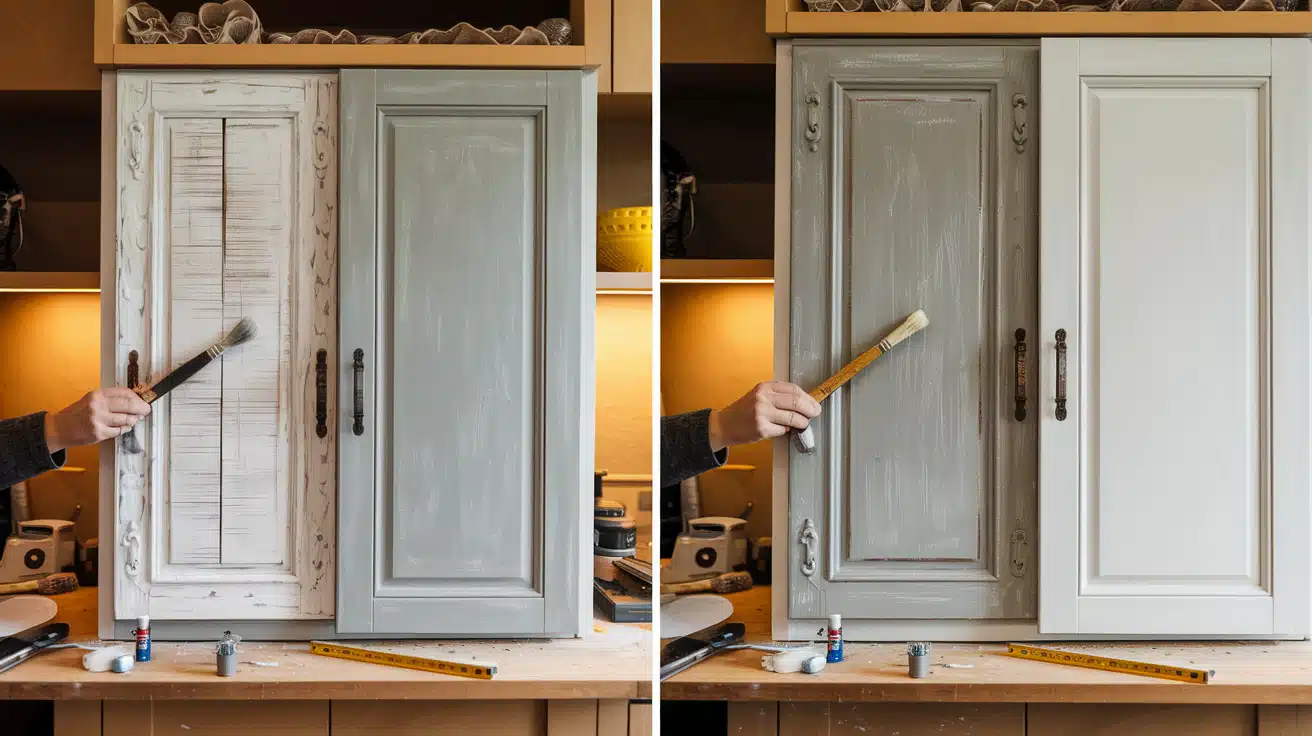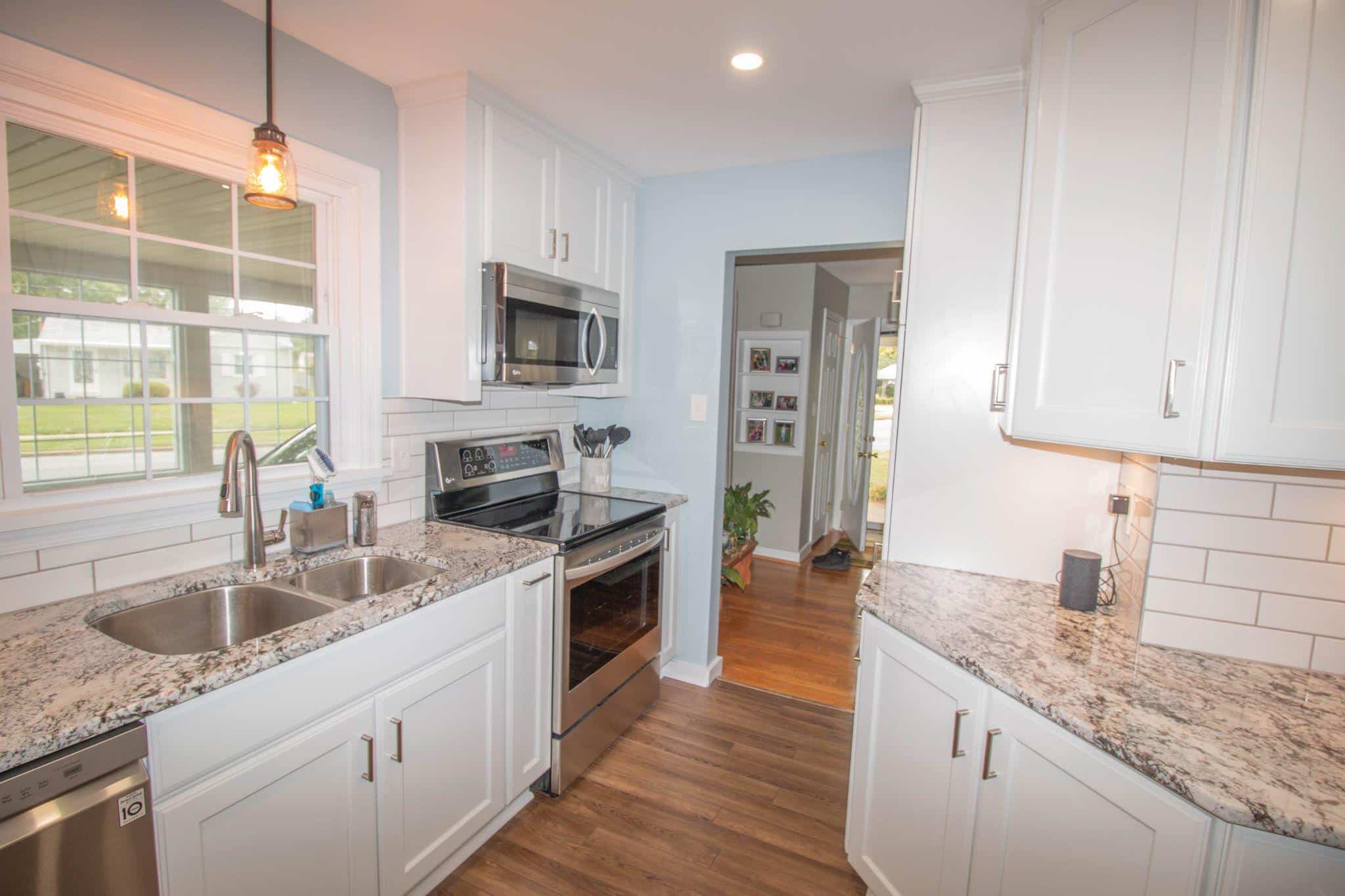Most homeowners know the pain of outdated cabinet doors.
I faced this issue in my kitchen last year – the doors looked worn, but replacing them through a contractor would cost thousands.
Making custom cabinet doors saves money and gives better results than many store-bought options. You can create doors that fit your style with basic tools and the right steps.
In this guide, I’ll show you the exact process I use to build cabinet doors from scratch.
You’ll learn to measure correctly, choose the right materials, make precise cuts, and add those finishing touches that make your doors look professionally made.
By the end, you’ll have the skills to create doors that match your vision and budget.
Materials and Tools You’ll Need
| Category | Options/Items | Description |
|---|---|---|
| Wood Options | Plywood | Affordable, easy to work with, available in different grades. |
| MDF (Medium Density Fiberboard) | Smooth surface, ideal for painting, easy to cut. | |
| Hardwood (Oak, Maple, Cherry, etc.) | Durable, premium look, more expensive but provides strength and long-lasting appeal. | |
| Tools Required | Table Saw | Used for cutting straight lines and panels. |
| Drill | For making holes for screws, hinges, and handles. | |
| Screws | This is for assembling the frame and securing the panel. | |
| Clamps | Necessary for holding pieces together while the glue dries. | |
| Hinges | For attaching the doors to the cabinet frame. | |
| Additional Supplies | Paint | To finish the doors with a color. |
| Stain | Used for giving the wood a rich, natural finish. | |
| Clear Coat | Provides a protective layer over painted or stained surfaces. | |
| Handles/Knobs | To add functionality and style to the doors. |
How to Build a Traditional Shaker Door Using a Table Saw
Building a Shaker door requires attention to detail and careful measurements. In this guide, you’ll learn how to create a sturdy, long-lasting door using only a table saw.
While many woodworkers use multiple tools, this method proves that quality results are possible with basic equipment.
Step 1: Check Your Wood
Place each board on a flat surface. Good wood makes a good door. Look for boards that:
- Lay completely flat
- Don’t twist or bend
- Have straight edges
- Show no warping
Step 2: Cut Your Pieces
Start with these measurements:
- Two styles (vertical pieces): 28 inches long, 2½ inches wide
- Two rails (horizontal pieces): 10 inches long, 2½ inches wide
- Panel: 10 inches wide, 24 inches high
Use your miter gauge for straight cuts. Test each piece against its partner to ensure equal lengths.
Step 3: Make the Grooves
This step holds everything together:
- Set blade height to 9/16 inch
- Cut a test groove in scrap wood first
- Make sure your 3/16-inch panel fits the groove
- Cut grooves in all four frame pieces
Step 4: Shape the Rails
The rails need special ends to fit the styles:
- Set blade ¼ inch high
- Position fence ½ inch from blade
- Cut tongues on rail ends
- Test fit in style grooves
Step 5: Put It All Together
Assembly needs careful attention:
- Cover rail ends with glue
- Put one style flat on your workspace
- Add rails
- Slide in panel (keep it lower than rail tongues)
- Add second style
- Clamp and wait 30 minutes
Step 6: Final Touches
After the glue dries:
- Sand all joints smooth
- Round sharp edges slightly
- Drill holes for hinges (4 inches from ends)
- Install hinges
- Test door movement
Tips for Success
- Measure twice before any cut
- Keep test pieces nearby
- Clean up glue right away
- Check for square corners
- Take your time with each step
Remember: Good doors come from patience and careful work. Each step builds on the last, so take your time and check your work as you go.
Video Tutorial
Here’s the guide to creating your own Shaker Cabinet Doors by “Build It With Jose“
Additional Tips for Customization
Want to make your Shaker door unique? Here are quick ways to adapt the basic design:
- Switch between maple (for natural finish) or poplar (for painted doors)
- Adjust frame widths: go wider for large doors and slimmer for small ones
- Mix wood types between frame and panel for visual interest
- Choose panel thickness (3/16 inch or ¼ inch) based on door size
- Pick hinge styles to match your needs (standard or soft-close)
- Use plywood panels for extra-large doors to prevent warping
Remember: Adjust all related pieces to keep proper proportions when changing measurements.
Troubleshooting Common Issues
When building Shaker doors, you might face some common challenges. Here’s how to fix them:
Uneven Joints
If your joints don’t line up perfectly:
- Check rail lengths are exactly equal
- Verify your saw blade is set at 90 degrees
- Make sure test fits feel snug before gluing
- Use consistent pressure when clamping
Panel Problems
When the panel doesn’t fit properly:
- Ensure groove depth is uniform on all pieces
- Check panel dimensions are slightly smaller than the opening
- Make sure the panel sits lower than the rail tongues during assembly
- Leave room for wood movement in grooves
Door Won’t Close Right
If the door doesn’t hang correctly:
- Check hinge holes are all the same depth
- Verify hinges are aligned straight
- Adjust the hinge position slightly if the door shifts
- Make sure the cabinet face is flat
Gaps in Assembly
To fix visible gaps:
- Test joint fits before applying glue
- Clean grooves of any debris
- Use enough clamps during assembly
- Keep even pressure while the glue dries
Remember: Most problems can be prevented with careful measurement and testing before final assembly.
Conclusion
Making a Shaker door with just a table saw shows beautiful results from simple tools and careful attention.
Remember the key points: start with straight, quality lumber, take time with your measurements, and test each step before moving forward.
Your success depends on precise groove cutting and proper panel fitting. These elements ensure your door will work well and last for years.
Keep your test pieces, maintain consistent pressure during cuts, and never rush the assembly process.
If you’re new to woodworking, this project teaches valuable skills that apply to many other tasks. Take your time, follow the steps carefully, and don’t hesitate to make test cuts on scrap wood first.
Ready to start? Gather your materials, set up your table saw, and create something combining function and lasting quality.
Frequently Asked Questions
Is It Cheaper to Build Your Cabinet Doors?
Yes, making your doors saves 30-50% compared to pre-made options. You’ll need basic tools and time, but materials cost less than ready-made doors.
What Can You Use for Cabinet Doors?
Common materials include:
- Solid wood (maple, oak, poplar)
- MDF
- Plywood with wood frames
- Laminate panels
What Is the Cheapest Way to Do Kitchen Cabinets?
Paint existing cabinets or build simple doors using MDF or affordable wood like poplar. Ready-to-assemble (RTA) cabinets offer another budget-friendly option.
Can I Just Buy Doors from Diy Kitchens?
Yes, many suppliers sell doors separately. Just measure carefully and check hinge compatibility with your existing cabinets.









